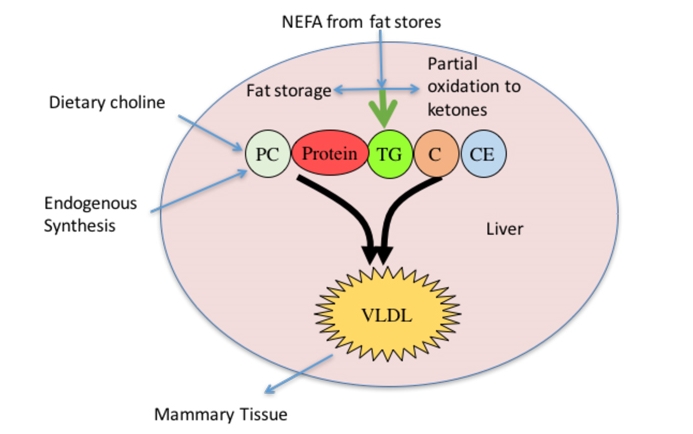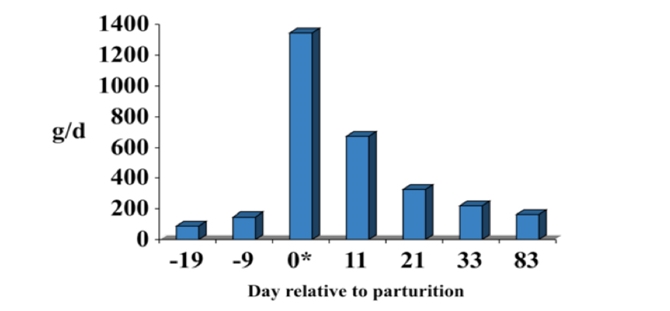Myth #4: Choline is a Feed Additive For Problem Cows/Herds
Many nutritionists and veterinarians view choline as a feed additive that should only be fed when herds are having transition cow problems. They realize choline has a role in preventing fatty liver and ketosis. Given the biology discussed below, and the fact that over-conditioned cows are particularly susceptible to fatty liver and ketosis, it is not surprising that for many advisors choline only gets recommended for herds with too many fat cows.
BACKGROUND
Choline has many roles in the biology of a dairy cow. It is intricately involved in methyl group transfer, playing a role in energy and protein metabolism, gene expression, and neurotransmission. It is an important precursor for synthesis of phosphatidylcholine (PC). PC is a constituent of all cell membranes as well as milk fat globule membranes. PC is required for the assembly of lipoproteins and transport of fat within and between organs. Of particular importance is PCs role in the synthesis of very low density lipoproteins (VLDL). VLDL are responsible for exporting fat out of the liver. As discussed in previous mythbuster articles, fat export out of the liver is critical in transition cows during periods of intense mobilization of fat from tissue storage. Approximately 25-30% of non-esterified fatty acids (NEFA) that are released from fat stores may be taken up by the liver and it is very important that they get packaged into a VLDL for delivery to the mammary gland and other tissues rather than be stored as fat in the liver or converted to ketones (Figure 1). If PC is limiting, VLDL production is limited and consequently, fat storage and ketone production may be increased.
*FIGURE 1
The preferred fate of NEFA reaching the liver is incorporation into triglyceride (TG) and exportation to tissues such as the mammary gland as a constituent of very low density lipoproteins (VLDL). Choline, as phosphatidylcholine, is required for VLDL synthsis.

BUSTING THE MYTH: CHOLINE NEEDS TO BE SUPPLEMENTED TO ALL COWS!
The myth that choline is only for overweight cows is perpetuated due to an incomplete understanding of choline biology. In every animal that choline has been studied, it has been shown to be an essential nutrient. That means that the body cannot synthesize sufficient choline for good health, therefore, it must be supplied by the diet. Since dietary choline is extensively degraded in the rumen, additional .pressure is put on the dairy cow to produce choline endogenously. During the transition period, particularly at calving, the cow suddenly experiences an increase in blood NEFA and NEFA uptake by the liver and the cow’s body simply can not make sufficient PC and VLDL to export adequate amounts of fat from the liver (Figure 2). In every animal it has been studied, fatty liver is the classic deficiency symptom of choline deficiency. All transition cows experience some accumulation of fat in the liver during the transition period. Numerous studies have indicated that 50% of transition cows experience moderate to severe fatty liver (Bobe et al., 2004), even when cows are well-managed and not over conditioned. Just the act of having a calf and initiating lactation causes hormonal changes that induce the surge in NEFA release from fat stores and creates a period of choline deficiency. This occurs in all cows, not just over conditioned cows. A recent study at the University of Florida (Zenobi et al., 2018) confirms that all cows, not just fat cows, benefit from being fed rumen-protected choline (RPC). One-half of the cows were fed a control diet and one-half were supplemented RPC from 3 weeks prior .to calving to three weeks post calving. When considering all cows on experiment (n=91), the average milk response to supplemental choline for the first 15 weeks of lactation was 4.8 lbs of milk per day. When considering cows with body condition score of 3.5 or less (n=76), average milk production response to RPC was 5.9 lbs of milk per day! Clearly, a cow doesn’t have to be over-conditioned to respond to RPC! Additional evidence that all cows need RPC comes from a meta-analysis of 13 transition cow studies that examined the benefit of feeding RPC. The average milk response from feeding RPC was 4.9 lbs per day and the P value was <.0001. A P value that low means that the milk response was extremely consistent between studies. Feeds, housing, genetics, country of origin, management, etc. varied across trials and over-conditioned animals were not the focus of these studies. This confirms that a cow only needs to have a calf to be able to benefit from RPC.
*FIGURE 2
Changes in NEFA uptake by the liver during the transition period. (Figure by Thomas Overton, Cornell University; created from data of Reynolds et al., 2004.)

TAKE HOME MESSAGE
Choline is an essential nutrient that is deficient during the transition period due to sudden changes in the cow’s biology that is orchestrated by hormonal changes associated with parturition and lactation. Dietary choline is extensively degraded and there simply is not sufficient endogenous synthesis of choline to meet all of the tissue requirements of the transition dairy cow. Supplementation of choline in a rumen-protected form benefits all transition cows because they all have a calf.
Sources
BOBE, G., J. W. YOUNG, AND D. C. BEITZ. 2004.
Invited review: Pathology, etiology, prevention, and treatment of fatty liver in dairy cows. J. Dairy Sci. 87:3105-3124.
GRUMMER, R. R. 2012.
Choline: A limiting nutrient for transition dairy cows. Proc. Cornell Nutr. Conf.
ZENOBI, M. G., R. GARDINAL, J. E. ZUNIGA, A. L. G.
Dias, C. D. Nelson, J. P. Driver, B. A. Barton, J. E. P. Santos, and C. R. Staples. 2018. Effects of supplementation with ruminally protected choline on performance of multiparous Holstein cows did not depend upon prepartum caloric intake. J. Dairy Sci. 101:1088-1327.
